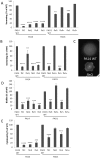Novel roles for two-component regulatory systems in cytotoxicity and virulence-related properties in Pseudomonas aeruginosa
- PMID: 31294209
- PMCID: PMC6605022
- DOI: 10.3934/microbiol.2018.1.173
Novel roles for two-component regulatory systems in cytotoxicity and virulence-related properties in Pseudomonas aeruginosa
Abstract
The rapid adaptation of the opportunistic bacterial pathogen Pseudomonas aeruginosa to various growth modes and environmental conditions is controlled in part through diverse two-component regulatory systems. Some of these systems are well studied, but the majority are poorly characterized, even though it is likely that several of these systems contribute to virulence. Here, we screened all available strain PA14 mutants in 50 sensor kinases, 50 response regulators and 5 hybrid sensor/regulators, for contributions to cytotoxicity against cultured human bronchial epithelial cells, as assessed by the release of cytosolic lactate dehydrogenase. This enabled the identification of 8 response regulators and 3 sensor kinases that caused substantial decreases in cytotoxicity, and 5 response regulators and 8 sensor kinases that significantly increased cytotoxicity by 15-58% or more. These regulators were additionally involved in motility, adherence, type 3 secretion, production of cytotoxins, and the development of biofilms. Here we investigated in more detail the roles of FleSR, PilSR and WspR. Not all cognate pairs contributed to cytotoxicity (e.g. PhoPQ, PilSR) in the same way and some differences could be detected between the same mutants in PAO1 and PA14 strain backgrounds (e.g. FleSR, PhoPQ). This study highlights the potential importance of these regulators and their downstream targets on pathogenesis and demonstrates that cytotoxicity can be regulated by several systems and that their contributions are partly dependent on strain background.
Keywords: FleSR; PilSR; Pseudomonas aeruginosa; WspR; adherence; biofilm; cytotoxicity; motility; two-component regulatory systems.
Conflict of interest statement
Conflict of interest: All authors declare no conflicts of interest in this paper.
Figures



Similar articles
-
The Pseudomonas aeruginosa PilSR Two-Component System Regulates Both Twitching and Swimming Motilities.mBio. 2018 Jul 24;9(4):e01310-18. doi: 10.1128/mBio.01310-18. mBio. 2018. PMID: 30042200 Free PMC article.
-
Overexpression of the Small RNA PA0805.1 in Pseudomonas aeruginosa Modulates the Expression of a Large Set of Genes and Proteins, Resulting in Altered Motility, Cytotoxicity, and Tobramycin Resistance.mSystems. 2020 May 19;5(3):e00204-20. doi: 10.1128/mSystems.00204-20. mSystems. 2020. PMID: 32430407 Free PMC article.
-
Sensor kinase PA4398 modulates swarming motility and biofilm formation in Pseudomonas aeruginosa PA14.Appl Environ Microbiol. 2015 Feb;81(4):1274-85. doi: 10.1128/AEM.02832-14. Appl Environ Microbiol. 2015. PMID: 25501476 Free PMC article.
-
Key two-component regulatory systems that control biofilm formation in Pseudomonas aeruginosa.Environ Microbiol. 2011 Jul;13(7):1666-81. doi: 10.1111/j.1462-2920.2011.02495.x. Epub 2011 May 9. Environ Microbiol. 2011. PMID: 21554516 Review.
-
The T6SSs of Pseudomonas aeruginosa Strain PAO1 and Their Effectors: Beyond Bacterial-Cell Targeting.Front Cell Infect Microbiol. 2016 Jun 9;6:61. doi: 10.3389/fcimb.2016.00061. eCollection 2016. Front Cell Infect Microbiol. 2016. PMID: 27376031 Free PMC article. Review.
Cited by
-
Roles of Two-Component Systems in Pseudomonas aeruginosa Virulence.Int J Mol Sci. 2021 Nov 10;22(22):12152. doi: 10.3390/ijms222212152. Int J Mol Sci. 2021. PMID: 34830033 Free PMC article. Review.
-
Context-Specific Requirement of Forty-Four Two-Component Loci in Pseudomonas aeruginosa Swarming.iScience. 2019 Mar 29;13:305-317. doi: 10.1016/j.isci.2019.02.028. Epub 2019 Mar 1. iScience. 2019. PMID: 30877999 Free PMC article.
-
The roles of calcium signaling and calcium deposition in microbial multicellularity.Trends Microbiol. 2023 Dec;31(12):1225-1237. doi: 10.1016/j.tim.2023.06.005. Epub 2023 Jul 8. Trends Microbiol. 2023. PMID: 37429751 Free PMC article. Review.
-
Loss of LasR function leads to decreased repression of Pseudomonas aeruginosa PhoB activity at physiological phosphate concentrations.bioRxiv [Preprint]. 2024 May 1:2024.03.27.586856. doi: 10.1101/2024.03.27.586856. bioRxiv. 2024. Update in: J Bacteriol. 2025 Jun 24;207(6):e0018924. doi: 10.1128/jb.00189-24. PMID: 38585852 Free PMC article. Updated. Preprint.
-
NtrBC Regulates Invasiveness and Virulence of Pseudomonas aeruginosa During High-Density Infection.Front Microbiol. 2020 May 5;11:773. doi: 10.3389/fmicb.2020.00773. eCollection 2020. Front Microbiol. 2020. PMID: 32431676 Free PMC article.
References
-
- Gellatly SL, Hancock REW. Pseudomonas aeruginosa: new insights into pathogenesis and host defenses. Pathog Dis. 2013;67:159–173. - PubMed
-
- Schurek KN, Breidenstein EBM, Hancock REW. Pseudomonas aeruginosa: a persistent pathogen in cystic fibrosis and hospital-associated infections. In: Dougherty TJ, Pucci MJ, editors. Antibiotic drug discovery and Development. Springer Publishing Company; 2012.
-
- Roy-Burman A, Savel RH, Racine S, et al. Type III protein secretion is associated with death in lower respiratory and systemic Pseudomonas aeruginosa infections. J Infect Dis. 2001;183:1767–1774. - PubMed
-
- Hauser AR, Cobb E, Bodi M, et al. Type III protein secretion is associated with poor clinical outcomes in patients with ventilator-associated pneumonia caused by Pseudomonas aeruginosa. Crit Care Med. 2002;30:521–528. - PubMed
LinkOut - more resources
Full Text Sources
